Skin Creation: Difference between revisions
(Marked this version for translation) |
m (remove gif from translation, make stub translatable) |
||
| Line 1: | Line 1: | ||
<languages/> | <languages/> | ||
{{Stub}} | {{Stub{{#translation:}}}} | ||
<translate> | <translate> | ||
| Line 19: | Line 19: | ||
Next, it's time to start making your skin. It's easiest to start from a pre-existing skin, or a template file. [https://github.com/ddnet/ddnet-data-svg/tree/main/skins This GitHub repo] contains many .svg remakes of popular skins. Let's take a look at the default skin .svg: | Next, it's time to start making your skin. It's easiest to start from a pre-existing skin, or a template file. [https://github.com/ddnet/ddnet-data-svg/tree/main/skins This GitHub repo] contains many .svg remakes of popular skins. Let's take a look at the default skin .svg: | ||
< | </translate> | ||
[[File:Default skin svg.png|thumb|default.svg]] | [[File:Default skin svg.png|thumb|default.svg]] | ||
<translate> | |||
<!--T:6--> | <!--T:6--> | ||
As we can see, each body part has a corresponding black shadow version. | As we can see, each body part has a corresponding black shadow version. | ||
Revision as of 19:25, 22 February 2023
Skin files are 32-bit RGBA formatted in a 2:1 ratio. Each side of the image must be divisible by 4 pixels.
To create a skin, you'll need the appropriate software before you begin. It's advised to use a vector graphics image editor, as they produce clean exports and are easy to edit. Some popular choices are:
- Inkscape (free, open-source, and the choice of this tutorial)
- Adobe Illustrator
- Affinity Designer
Next, it's time to start making your skin. It's easiest to start from a pre-existing skin, or a template file. This GitHub repo contains many .svg remakes of popular skins. Let's take a look at the default skin .svg:

As we can see, each body part has a corresponding black shadow version.
The black shadow of each body part is the outline used in the tee as a whole.
Make sure these share the same shape as each body part, but with a larger stroke size.
